Physical Address
304 North Cardinal St.
Dorchester Center, MA 02124
Tracheal anomalies in children represent one of the greater challenges in pediatric otolaryngology. In addition to the compromised airway, there is a high prevalence of associated anomalies. Despite surgical and technologic advances, significant morbidity and mortality remain.
Advances in molecular biology and development of novel animal models have challenged older theories of foregut development and have allowed increased understanding of the pathophysiology of congenital airway anomalies.
Bronchoscopy is the gold standard for diagnosis and should be performed with the patient spontaneously ventilating. No attempt should be made to force a scope through a critical stenosis.
Radiographic imaging is an important adjunct to precisely characterize airway anomalies and any associated cardiovascular anomalies.
Tracheomalacia (TM) is defined as more than 50% collapse of the trachea. It may be classified as either primary (intrinsic) or secondary (caused by compression); the majority of patients with primary TM have mild to moderate severity and can be managed expectantly until spontaneous resolution occurs.
Endoscopic procedures have become very effective in the management of short, acquired tracheal stenoses, although their application in longer segment stenoses is limited.
Endotracheal stents are useful for short-term support of the pediatric airway in several situations. Although initially effective in maintaining patency of the airway, wire stents have a high rate of associated complications and should be used only in salvage situations and when all other surgical options have been exhausted.
Slide tracheoplasty is the preferred surgical treatment for long-segment congenital tracheal stenosis (CTS) with complete rings. For short stenoses, segmental resection and reanastomosis is preferred.
Advances in tissue engineering and transplant medicine have opened a new array of possibilities for tracheal reconstruction.
Esophageal atresia (EA), with or without tracheoesophageal fistula (TEF), is the most common congenital anomaly of the esophagus. Of the five variations, EA with distal TEF (85%) is most commonly encountered.
The authors wish to acknowledge the contributions of Dr. Marc Nelson to previous versions of this chapter.
Congenital tracheal anomalies are often associated with critical airway narrowing and severe associated comorbidities. Morbidity and mortality remain significant. Many novel treatments are being developed to improve the results for these children.
The symptoms of congenital tracheal anomalies are generally related to the size of the airway. Mild obstruction can often be treated expectantly, whereas more significant lesions may require airway support, repair of associated anomalies, tracheal reconstruction, or novel bioengineered solutions. Airway size may be decreased secondary to collapse, congenital narrowing, intraluminal tissue ingrowth, or extrinsic compression. The etiology and degree of narrowing define the treatment algorithm.
At 4 weeks of gestation, the foregut develops a laryngotracheal groove, which extends from the ventral aspect of the primordial pharynx caudal to the fourth branchial arches to produce a laryngotracheal bud. The laryngotracheal bud is circumferentially invested with splanchnic mesenchyme. The endoderm develops into respiratory epithelium and glands, and the splanchnic tissue will differentiate to the cartilage, connective tissue, and muscles of the airway.
A long-held hypothesis is that the foregut develops bilateral indentations called tracheoesophageal folds or lateral ridges, which migrate medially in a pinching motion to fuse and create the tracheoesophageal septum, which, ultimately, separates the trachea from the esophagus. This process begins caudally and extends cranially under the controlled balance of epithelial proliferation and apoptosis, with the caudal end giving rise to the respiratory buds. However, data to substantiate the process of septation of the foregut are lacking, and these lateral ridges have not been identified in animal studies. , Alternate theories have been developed based on molecular biology and results from studies of directed mutagenesis with drugs such as doxorubicin, which produce a variety of foregut malformations. , Laryngotracheal clefts also arise secondary to abnormal development of the tracheoesophageal septum (see Chapter 214).
In summary, no consensus has been reached regarding the process of airway development.
Endoscopic visualization of the airway is essential for correct diagnosis and characterization of tracheal pathology. Intravenous (IV) dexamethasone is administered to the patient prior to instrumenting the airway. The patient is initially mask ventilated, and then the vocal folds are topically anesthetized with lidocaine. It is essential to maintain spontaneous ventilation to allow true assessment of any dynamic collapse of the airway. A laryngoscope is positioned, and insufflation of oxygen and inhalational agents is provided either via the side port of the laryngoscope, nasal cannula, or with an endotracheal tube (ETT) placed in the pharynx. A 2.7-mm or smaller rigid, 0-degree telescope connected to a monitor with video recording is typically used to assess the airway. Observations during bronchoscopy should include subglottic diameter; presence of complete tracheal rings ( Fig. 30.1A ); length and position of stenosis ( Fig. 30.2 ); scar formation; malacia of any segments of the airway ( Fig. 30.3 ), because the position and shape of the airway can often help determine which vascular structure might be the cause; presence of fistula involving the posterior wall, often above the carina; abnormalities in tracheobronchial branching and, in particular, the presence of a tracheal bronchus ( bronchus suis ) ( Fig. 30.4 ); and the presence of mainstem bronchomalacia.
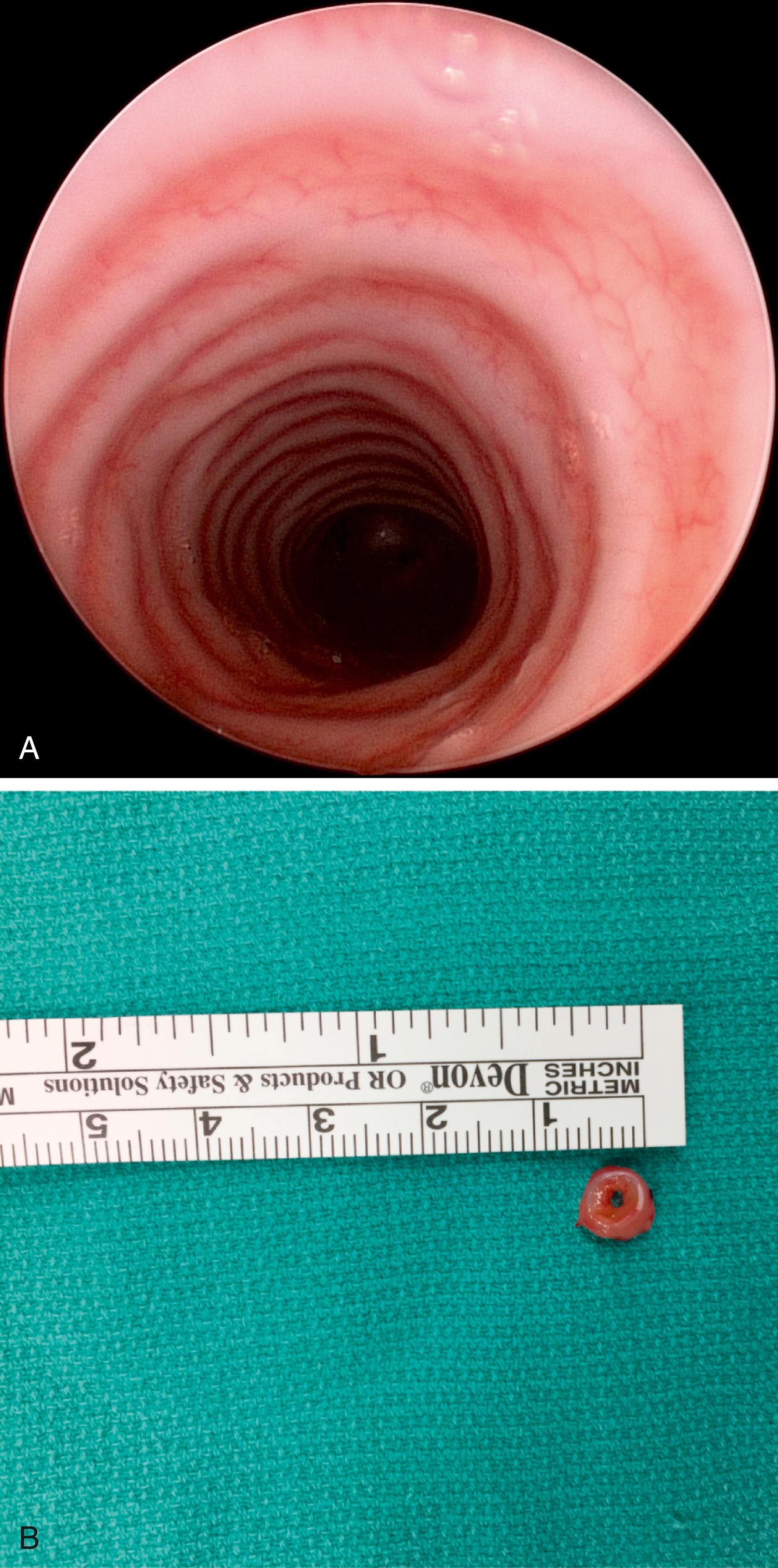
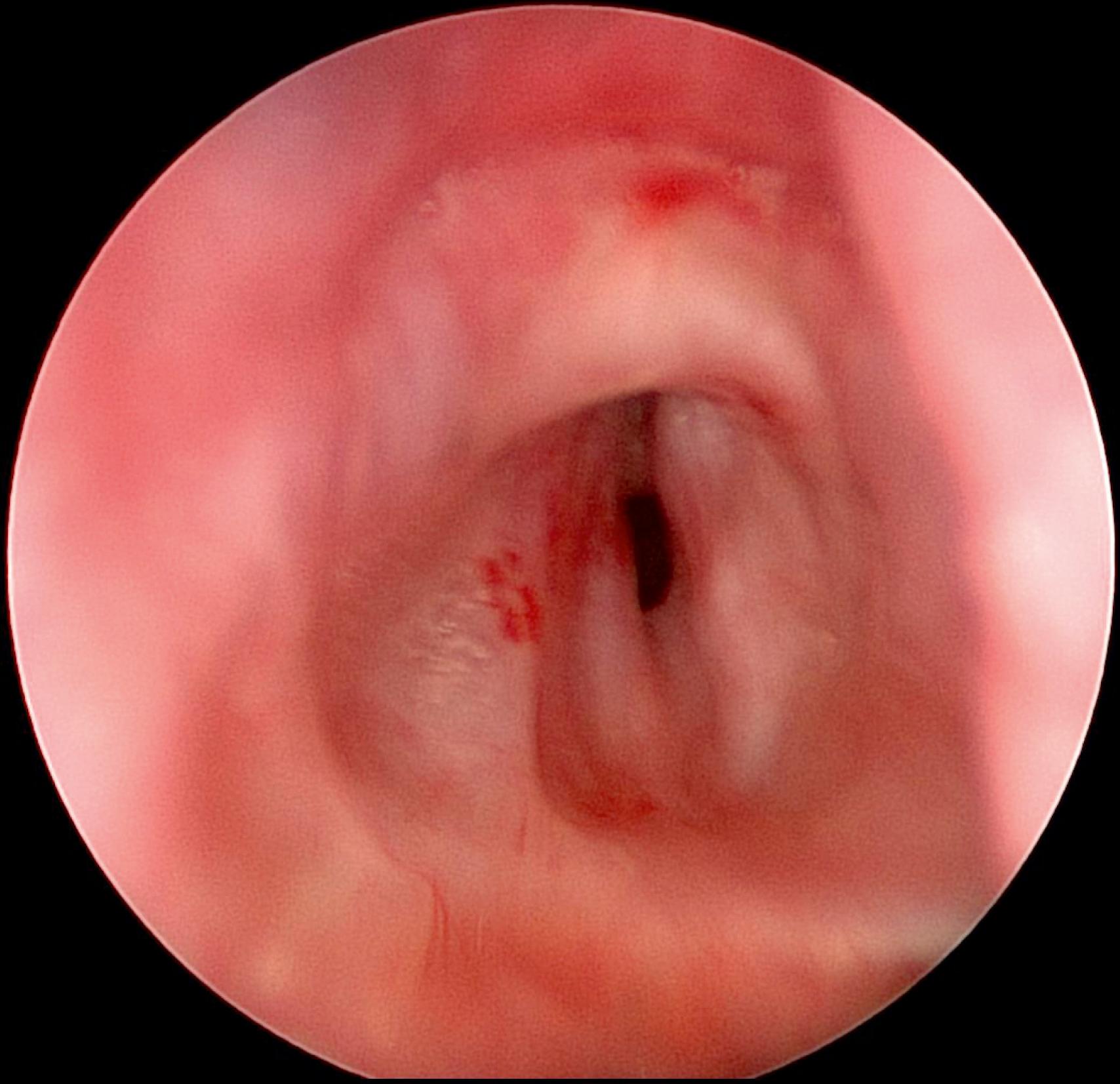
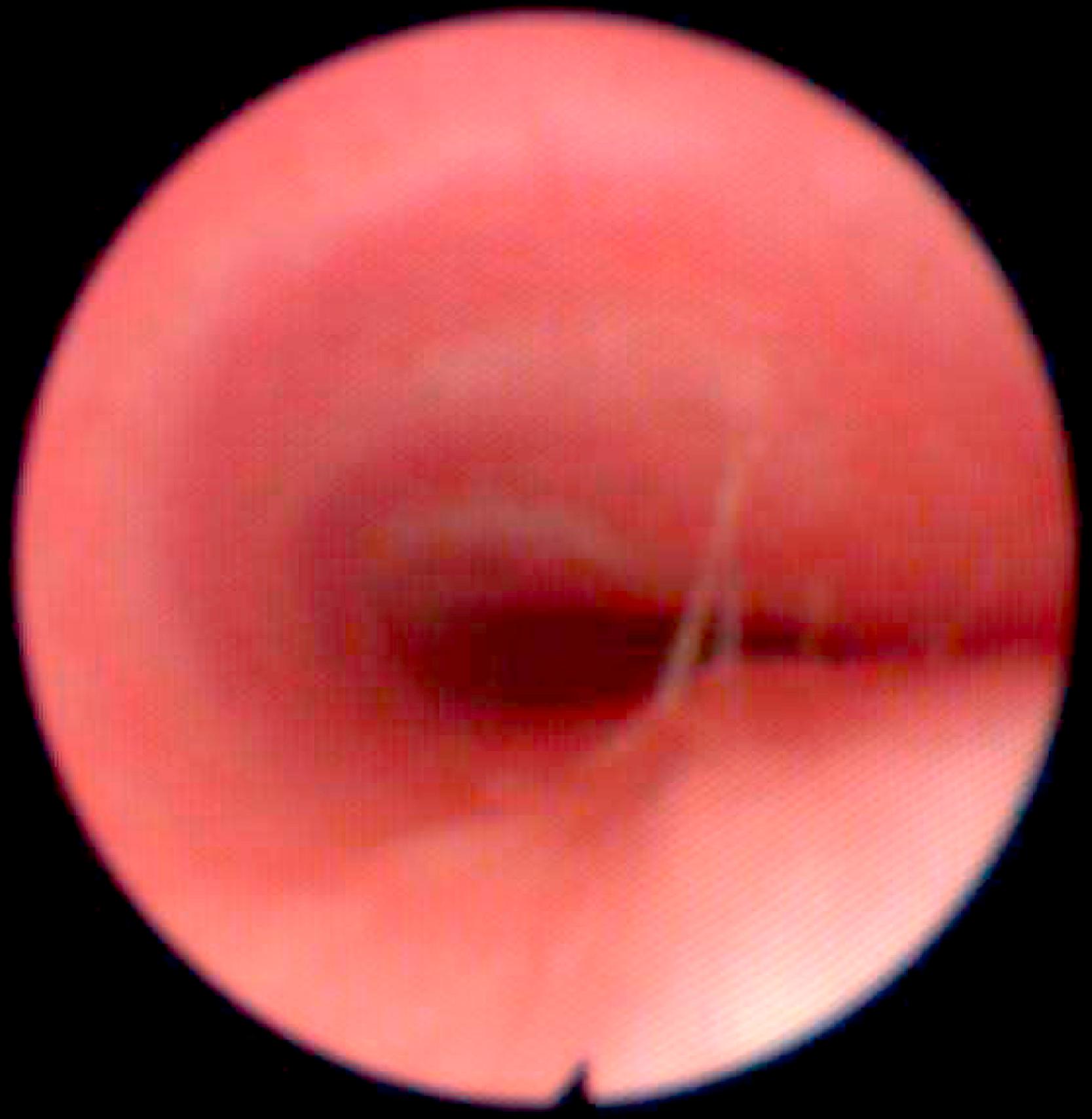
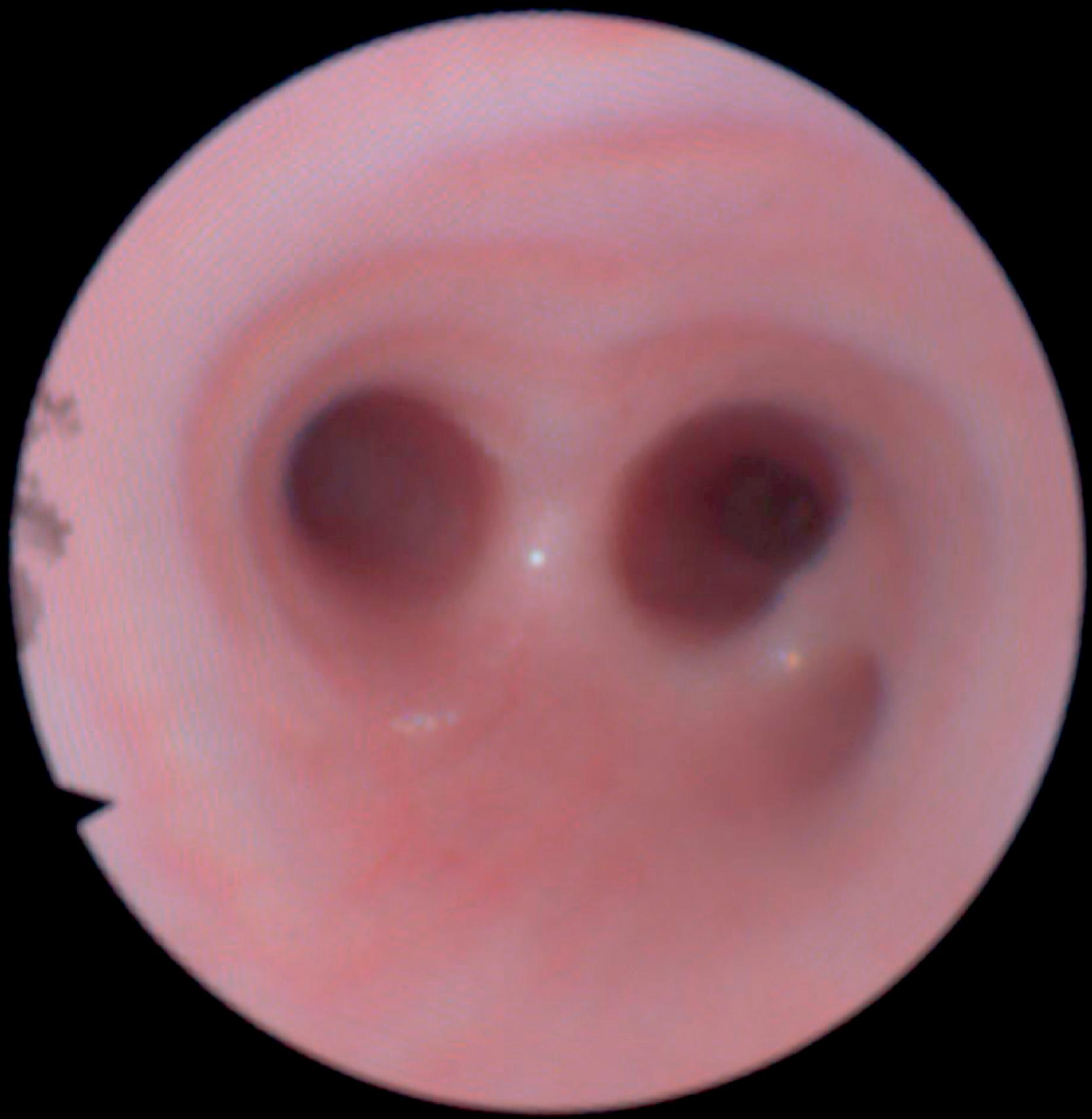
Complications of bronchoscopy may include mucosal trauma, laryngospasm, bradycardia, pneumothorax, bleeding, and edema, any of which may contribute to the loss of the ability to oxygenate or ventilate the patient. A telescope or bronchoscope should never be forced through a stenotic or edematous area because even minor mucosal trauma may precipitate complete airway obstruction.
The rigid bronchoscope allows more control over the airway at the expense of a larger diameter (generally at least 1 mm larger than the telescope alone). Flexible bronchoscopy may also be useful; the bronchoscope can be placed through a ventilating mask, suspension laryngoscope, or the nasal passage. Ultrathin flexible bronchoscopes (diameter 1.8 mm) allow similar visualization compared with the telescope; however, these scopes do not have a suction channel or side port and do not support ventilation, and resolution is reduced compared with the telescope. Hayashi and colleagues have described the use of a stereovision flexible bronchoscope (outer diameter 2.2 mm). Flexible bronchoscopy performed under a lighter plane of anesthesia is more accurate in the diagnosis of tracheobronchomalacia than rigid bronchoscopy.
Multiple radiographic modalities can provide unique information about tracheal anomalies and their commonly associated findings. Plain film radiography provides limited diagnostic information for many tracheal anomalies but may show postobstructive hyperinflation, postobstructive pneumonia, or narrowing of the tracheal air column. Airway fluoroscopy, when available, may be helpful for dynamic assessment of tracheomalacia (TM), tracheal stenosis, or vascular compression in children who are unable to tolerate bronchoscopy. However, fluoroscopy is a less sensitive method for detection of mild airway compression. Indentation of the esophagus visualized during a barium swallow can suggest incomplete or complete vascular rings. Contrast bronchography is rarely performed at present.
Advances in computed tomography (CT) allow three-dimensional multiplanar reconstructions and virtual bronchoscopy. Axial CT remains the radiographic study of choice for evaluating the pediatric airway. Use of inspiratory and expiratory imaging allows some assessment of dynamic changes in the airway. However, CT uses ionizing radiation and may require IV contrast to show vascular structures well.
Virtual bronchoscopy is produced by postprocessing CT data, most commonly obtained in a single breath hold at end inspiration. Internal rendering of CT data produces a virtual luminal view that imitates bronchoscopy, whereas external rendering produces CT bronchography, which illustrates the airway’s dimensions and its relationship to adjacent structures. The advantage of virtual bronchoscopy is the ability to provide information about the poststenotic portion of an airway that is too narrow to allow even small bronchoscopes to safely pass. Several studies have demonstrated good accuracy of this modality in assessing tracheobronchial stenosis, but it may not be as effective for malacia, and it can occasionally be misleading for the finer anatomic details required for surgical planning. As this technology improves over time, it has the potential for better utility in diagnosing and characterizing various tracheal anomalies.
Magnetic resonance imaging MRI and MR angiography (MRA) provide good detail of cardiovascular anatomy, accuracy in assessing the larger airways, and multiplanar capability. In many centers, MRI/MRA has replaced conventional angiography for assessment of vascular rings. Conventional MRI is unable to provide dynamic information on the airway throughout the respiratory cycle. In contrast, cine MRI uses real-time continuous acquisition of the airway to demonstrate dynamic collapse or stenosis, and it samples images at different phases of the respiratory cycle. Disadvantages of MRI include a longer acquisition time (30 to 60 minutes) and the potential need for sedation, which are particularly problematic in children who already have a tenuous airway.
Many centers use echocardiography to delineate congenital heart anomalies, given the high frequency of cardiac comorbidities with tracheal anomalies. In experienced hands, echocardiography may be sufficient to diagnose vascular rings, the most commonly encountered cardiovascular comorbidity; however, some centers may prefer to use CT or MRI/MRA. Echocardiography does not allow identification of the atretic segments of aortic branches involved in vascular rings and is limited in evaluating airway compression. ,
In summary, radiographic studies may complement endoscopy, but they cannot supplant it. With further technical advances in imaging, the diagnostic algorithm to evaluate tracheal lesions will continue to evolve.
Tracheal agenesis is a rare congenital anomaly with nearly universal mortality. Approximately 100 cases have been described. At birth, patients have an aphonia or absent cry, respiratory distress, increasing cyanosis, and declining Apgar scores. If a tracheoesophageal fistula (TEF) is present, bag mask ventilation or esophageal intubation, accidental or purposeful, may temporize for the inability to adequately ventilate. Laryngoscopy may demonstrate absence of vocal folds, and tracheal rings are not palpable in the neck. A nasogastric tube may not pass to the stomach if esophageal atresia (EA) is present.
The most commonly used classification system for tracheal agenesis was proposed by Floyd ( Fig. 30.5 ). In type I, the proximal trachea is absent, and the airway connects to a distal TEF. In type II, which is most common, the carina arises from the lower esophagus. In type III, the mainstem bronchi originate from two separate anastomoses with the esophagus.
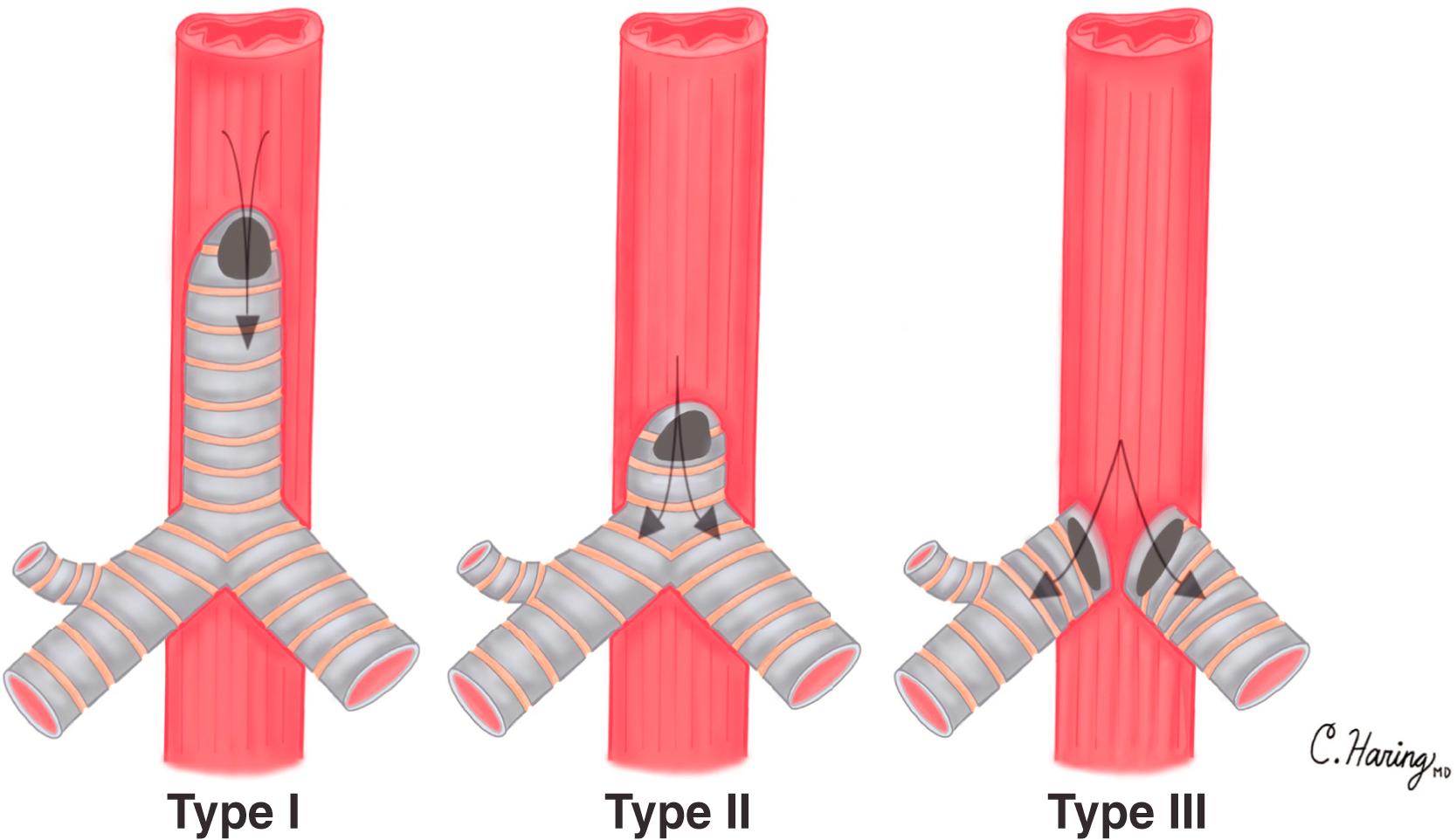
Patients with tracheal agenesis may be nonsyndromic or have features of VACTERL association ( v ertebral defects, a nal atresia, c ardiovascular defects, t racheoesophageal fistula or e sophageal atresia, r enal defects, and l imb defects). Multiple congenital anomalies have been described in association with tracheal agenesis, and there is no predominant molecular etiology. , A systemic workup is indicated to identify the severity of any comorbidities before embarking on treatment.
Surgical correction, if undertaken, involves using the esophagus and fistula as a neotrachea, with a double-barrel proximal esophagostomy (the superior end for salivary fistula and the inferior end for the stoma of a neotrachea). The esophagogastric junction is divided, and if EA is not present, the stump is oversewn. A gastrostomy is placed for alimentation. A small number of children with tracheal agenesis have survived beyond the first year of life. Watanabe and colleagues described the survival of a child for more than 4 years with normal neurodevelopment by using the previously mentioned strategy, with the addition of an external esophageal splint, in which the collapsible esophageal walls are held open as a neotrachea by permanent retracting sutures attached to the splint. Tissue engineering may offer hope for these patients in the future.
Tracheal webs are less common than laryngeal glottic webs. They are typically amenable to endoscopic management, although resection and reanastomosis is an option.
EA, with or without TEF, is the most common congenital anomaly of the esophagus (1 in 3500), and survival has improved dramatically over the past several decades and further from 1980–2020. Five types of anomalies are encountered: EA with distal TEF (85%), isolated EA without TEF (8%), H-type TEF (4%), EA with proximal TEF (3%), and EA with proximal and distal TEF (<1%). These entities can occur in isolation or as part of a syndrome or spectrum of associated anomalies, such as VACTERL and CHARGE ( c oloboma of the eye, h eart defects, a tresia of the anal choanae, r etardation of growth and/or development, g enital and/or urinary abnormalities, and e ar abnormalities and deafness) associations. Up to 50% of patients will have other congenital anomalies, most commonly cardiovascular anomalies.
Most of these patients will be diagnosed shortly after birth, either by the inability to pass a 10F catheter beyond 10 cm, excessive drooling, respiratory distress, or cyanotic episodes during nursing. A chest radiograph may show a gastric bubble if a distal TEF is present, along with air in the proximal pouch. Endoscopy can be useful for the diagnosis, particularly as an alternative to contrast studies with their associated risk in this setting.
Surgical treatment options include placement of an immediate gastrostomy followed by attempted primary anastomosis at 3 months, or the Foker technique, which attempts to elongate the esophagus with external traction sutures prior to anastomosis. The procedure begins with closure of the fistula at the trachea, followed by the EA repair via thoracotomy. Long-gap EA, defined as greater than 3 cm or the height of two vertebrae, is more challenging and sometimes requires rotation of a pedicled colonic or gastric interposition flap or a free jejunal graft. Complications include anastomotic leaks, esophageal strictures, and esophageal dysmotility; TM and gastroesophageal reflux disease (GERD) are both common. In a long-term study of the Helsinki experience, Sistonen and colleagues found that only 20% of patients with repaired EA had normal pulmonary function.
More recently described, closure of TEFs with endoscopic techniques including the use of cauterization and trichloroacetic acid have been reported, with promising early results, particularly for H-type fistulas. More than one treatment is often needed, and long-term results are not known.
Become a Clinical Tree membership for Full access and enjoy Unlimited articles
If you are a member. Log in here